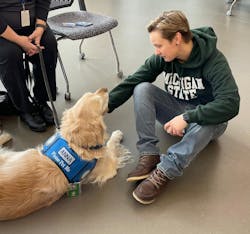Two thousand hours is about 83 days. In dog years, that’s equivalent to about 2½ years. Why is this important? It demonstrates the training that goes into a comfort dog, particularly those that are part of the Lutheran Church Charities (LCC) K-9 Comfort Dogs Ministry.
Devorah, a golden retriever, is one of 130 LCC comfort dogs in 27 states that works with hospitals, schools, churches and, you guessed it, first responders.
Per the American Kennel Club, comfort dogs are conditioned to be comfortable in new environments, to interact with different people, to have a calm temperament, to be unfazed by unfamiliar noises and movements, to be comfortable being handled and to “love people.”
Devorah and her caregiver, Bonnie Fear, live together in Fort Collins, CO. Fear, who is the LCC K-9 response coordinator, says LCC’s dogs build connections after a tragedy that people sometimes can’t.
“They don’t judge,” Fear says of the dogs. “They love people, and they know when someone is sad or happy or depressed or hurting. They can sense that, because they’re trained to.”
Devorah works 3–4 hours one day per week with her first responder handlers, visiting other first responders who might have experienced a traumatic call.
“By the time we’re done, there’s joy. The transformation is very heartwarming,” Fear says.
Devorah is part of larger network of comfort dogs that also interact with those who were affected by tragedies, such as the recent mass shooting in Allen, TX, or the spring tornadoes in the southern states.
Fear says many people, first responders included, will talk to a comfort dog before they will talk to people. It helps the first responders to process the stress or grief that they might be experiencing.
LCC’s K-9 comfort dogs were deployed five times in 2023 as of press time, including to the one-year anniversary of the Uvalde, TX, mass shooting, which claimed the lives of 19 students and two teachers at Robb Elementary School on May 24, 2022.
How different would these tragedies look for first responders and the victims without the presence of the comfort dogs? Fear says those connections never would have existed. Explaining further that dogs never are forced on anyone, LCC only responds when invited.
“The dogs are a bridge,” Fear says. “On the scene is where we connect with people, but the dogs do all of the work.”
Animal contact during stress
Comfort dogs are a growing trend in the first responder community, whether it’s to provide comfort to fire and EMS personnel or to the patients for whom we provide care. This largely is in part to the recognition of the shortage of mental wellness resources for EMS and fire.
Dr. Abby Morris, who is the medical director for the IAFF Center of Excellence, works with and treats addiction and behavioral health disorders in the first responder community. Morris and Dr. Danny Whu, who is IAFF Chief Medical Officer, are working on a pilot program to embed dogs in 10 busy fire stations in the Miami area.
“There have been countless studies showing the benefits of animal contact during times of stress or to predict medical or emotional problems before they occur, such as seizures, nightmares, panic attacks, etc.” Morris says.
Scientifically speaking, dog-human interaction, particularly the calming effects of petting a dog, can release oxytocin, which is a naturally produced peptide hormone and neuropeptide that produces calming effects, which lowers blood pressure and reduces the heart rate.
Mass shootings, psychiatric calls, MVA fatalities and domestic/child/elder abuse are all too common for street level first responders. Perhaps with dogs by our side, we can better respond to a changing EMS landscape.
About the Author

Kristen Wade
Kristen Wade is a battalion chief and EMS program manager with the Sugar Grove, IL, Fire Protection District and is in charge of an engine and ambulance company. She has nearly two decades of experience in the fire service and 15 years of experience as an Illinois licensed paramedic. Wade served as an instructor for the Illinois Fire Service Institute’s fire officer program. She is certified by Illinois Firefighter Peer Support. The organization focuses on the mental health and wellness of EMS and fire personnel. She obtained a bachelor’s degree in English communications from Fort Lewis College.
